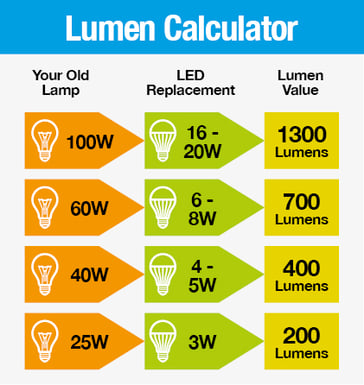
LED Terminology
From Kelvin temperature to CRI, what does it all mean? We'll explain what you need to know when discussing LED technology for your home or business.
Kelvin Temperature
What is the difference between "warm light" and "daylight"? There are so many different descriptions of Kelvin temperature to simplify for the everyday consumer. Understanding the Kelvin temperature scale will ensure that you select the right kind of bulb every time.

- 2700K is most familiar - it’s the closest color of light that a typical incandescent bulb emits
- 3000K is the most common in residential LED downlighting
- 4000K-5000K is recommended for tasks that involve a high level of focus
The confusing part of the temperature scale is when different manufacturers of LED call certain levels different things. To one manufacturer, 3500K might be considered daylight or warm white. Daylight could be 4000K or 5000K, so it's best to just know what number you're looking for when shopping for an LED product instead of wording!
The ability to adjust Kelvin temperature comes in handy not only in the home, but in places like schools. There have been a few studies showing that a higher Kelvin temperature in the classroom has shown that children keep their focus a little longer. The higher color temperature is intended to reflect a similar feeling of a mid-day sun. This all has to do with our circadian rhythm. When we wake in the mornings, we tend to want the same color temperature as the sun produces - a warmer glow, near 2700K or lower. The same goes for when we’re getting ready for bed. Our brains get the message when we see the world in that warm sunset glow! Our phones now have a “blue light” feature that makes our screens a warmer color before bed time, and this is why smart bulbs that can automatically adjust the color of light are all over the market.
When installing ceiling lighting, it’s wonderful to have the selection of Kelvin temperature incorporated into the fixture itself! Take for example Elite Lighting’s Multi-CCT & Multi-Lumen fixtures.
Not only do you have the choice of what Kelvin temperature your fixture emits, but you can also choose the lumen output.

Which leads us to discuss lumens.
Lumens
Lumen is defined as “the measurement of light a bulb emits”.
We’re used to speaking in wattage. It’s easy to visualize the brightness of a 60W bulb. You're familiar with that. Do you know how many lumens that would produce if it were an LED bulb? Or better yet, how many watts that LED bulb would use for that level of brightness?
Not as easy!
The easiest way to get used to lumens is the chart below:

A typical 60W incandescent bulb would only use about 6-8W of electricity to produce the same amount of light. And that's about 700 lumens.
This should speak on the efficiency and energy-savings of LED technology.
CRI
CRI = "Color Rendering Index"
A CRI value of 100 means that you're seeing the true color of an object.
So if you're in the market for LED lighting, the higher the CRI value, the better you'll be able to tell if that sock you pulled out of your drawer is blue or black. You could purchase an LED bulb with a Kelvin temperature of 4000K and a CRI value of 90 and a 2700K bulb with a CRI value of 85. The temperature of light doesn't necessarily mean that the CRI value will be the same. CRI truly speaks on the quality of light that's emitted.
You'll want to always look for a product that has the highest CRI value!
LED Quality
Not all LEDs are created equal!
An expert eye can identify a lesser-quality LED product by noticing the slight Kelvin temperature variation within the same light source. Combining different Kelvin temperatures can actually bother the eye! Our eyes enjoy one consistent color temperature. Otherwise, it's straining on the eyes and breaks our focus more easily. Quality LED manufacturers check those tiny diodes to make sure they're emitting the same amount and color of light.
Check out this informative video about how quality LEDs are manufactured. This is a reason to buy from a distributor that puts emphasis on selling quality lighting.
New LED products to try!
Manufacturers are producing even better, more customizable LED products.
We are excited for the Elite Lighting multi-lumen and multi-CCT (Kelvin temperature) LED products!
We have many types of residential and commercial products available in stock from Elite, so inquire with your sales rep or nearest branch today!

The market of LED products is advancing every day. Wiseway Supply always strives to feature the most up-to-date and reliable electrical supplies from brands that you love.
Want to make sure you're in the loop on the latest promotions, blogs, news and more?
Go ahead and hit that "Sign Up" button for our monthly Wise Bites newsletter.

